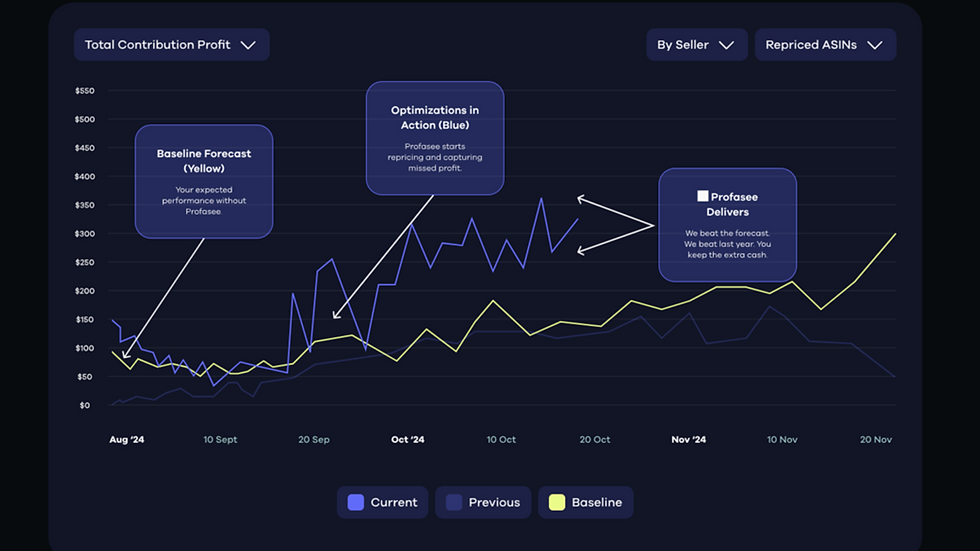5 PPC Mistakes Amazon Sellers Can’t Afford To Make This Q4
- Laura McCaul

- Nov 3, 2022
- 7 min read
Guest Post by: Laura McCaul - Co-Founder at Sponsored Profit

For Amazon sellers, Q4 can be a double-edged sword. While it can be the most lucrative time of the year, Cost per Clicks (CPCs) increase by an average of 30% between October and January with a staggering 2 million third-party sellers competing for those clicks.
Yet this Q4 is going to be more challenging than usual. Increased competition has already driven up the cost of ads by an average of 60% year over year. Increased overheads are squeezing profit margins. And the ever increasing number of ad placements are pushing organic placements further down the search results.
In this article, I’m going to list 5 costly PPC mistakes to avoid this Q4 and what to do instead so you can control ad costs, eliminate wasted ad spend, maximize sales and most importantly, increase profits.
Amazon PPC Mistake #1: Not Optimizing Your Product Listings
Setting and forgetting your product listings is one of the most common mistakes we see sellers - big and small - make.
The only reason Amazon shows your product - via organic placement or a sponsored ad - is because Amazon thinks a shopper might buy it. You must optimize your product listings to the fullest for clicks and conversions if you want to take advantage of the seasonal surge in traffic.
Optimize For Clicks
Target only the most relevant keywords with PPC
Check your top-performing keywords are in your product listing and back end search terms
Make sure your main keyword and benefit is at the beginning of the title
Make sure your main image is attractive and clearly shows what the product is
Optimize For Conversions
Use lifestyle images that show the product in use
Use text overlay in your images to highlight the benefits
Bullet points should be benefit-focused and emotionally persuasive
Use A+ or Enhanced Brand Content (EBC) to highlight your brand story and unique selling proposition
Some Do’s and Don’ts For Holiday Campaigns and Listings
DO create a separate campaign for greater budget control and easier optimization
DO use Brand Analytics to find search terms that are a combination of gift + your product for maximum relevancy e.g. “wallet gifts for men”
DON’T bid on generic holiday terms e.g. “holiday gifts for men”
DO set a limited budget. Treat this as a ‘research’ campaign until you have tested your keywords
DON’T forget to monitor your campaigns frequently to see what’s working and what’s not
DO optimize your product listing for the Holidays if you have a highly giftable product. For example use a holiday-themed template for images such as red and green colors, ribbons etc.
DO make sure to include the same keywords used in your Amazon PPC campaign in your listing
Amazon PPC Mistake #2: Not Purging The Bleeders
Based on our data brands misspend approximately 21.3% of their Amazon Advertising budget every single month on ads that don’t produce a single dollar in revenue. And this number can easily double during Q4 so it is vitally important to identify and eliminate unnecessary waste before increasing your budget for the Holiday season to prevent your campaigns from bleeding money.
At Sponsored Profit, we use our proprietary “Misspend Prevention” tool to cut wasted ad spend by an extra 53.7% without reducing sales and then re-allocate those ad dollars to the ads that are producing the most sales to drive more conversions and revenue.
We use a combination of 5 different techniques to find and eliminate inefficient, irrelevant and duplicate keywords. One of the most powerful of these techniques is the use of Negative Phrase Match Keywords.
Add Negative Phrase Match Keywords
Let’s say you sell a wooden scrubbing brush. In the below Search Term Report, there have been multiple occasions where your ads have been clicked on when someone has used the word “silicone” in their search.

This has resulted in $171 of wasted ad spend. If you add the single word ‘silicone’ as a negative phrase match keyword to these campaigns you can eliminate all of these clicks and wasted ad spend instantly.
By identifying and adding as many irrelevant single words as negative phrase match keywords as possible not only eliminates wasted spend but prevents that wasted spend going forward.
Amazon PPC Mistake #3: Treating All Keywords Equally
Have you heard of the 80/20 rule? Also known as the Pareto Principle, it states that 80% of output or results come from 20% of input or action.
If you pay attention to your Search Term Report, you will notice that roughly 20% of your search terms are driving 80% of your revenue. These are the select few search terms that you should focus your ad dollars on during the holiday period so you can make more sales and bigger profits.
Use Your Search Term Report To Find Your Best Performing Keywords
As a guide, consider best performing keywords to be those keywords that have 3+ sales, are highly relevant (i.e. have a CPC of 0.4% and above) and are within an acceptable Advertising Cost of Sale (ACoS) range.
When it comes to your target ACoS, you can set a slightly higher target than usual because conversion typically increases by approximately 30% during the holiday season, which in turn lowers ACoS. For example, if your regular target ACoS is 30%, you can target keywords and ASINs that have an ACoS of up to 39%.
Search Query Performance is one of the most powerful search term tools rolled out by Amazon to date. Found under Brand Analytics, it allows you to see your top 100 converting search terms by ASIN based on organic and paid data and compared to the category as a whole.
This means you can dial down the bids on terms that you convert for below category average to minimize wasted ad spend and double down on terms that you convert above category average for to give you an advantage over your competitors.
Amazon PPC Mistake #4: Using Automated Bidding Strategies
There are two main types of automated bidding strategies:
Dynamic bids: adjusts bids up or down in real time in the hopes of showing your ad for specific search terms that are more likely to generate a sale.
Bids by Placement: allows sellers to set the bid up to a 900% increase in order to get the ad to the top of search results.
The problem with these bidding strategies is you don’t have very little control over your bids. You are giving Amazon all the control. Plus, in many instances, Top-of-Search might not be the best placement for your ads.
That’s because Sponsored Product ads perform differently between top-of-search, rest-of-search, and product pages. It’s how your specific keywords convert at a cost effective CPC that matters. Targeting Top-of-Search placement at any cost can be a real money pit and drive up CPCs even further.
Set Your Bids By Conversion
Knowing the conversion rate for your product keywords will help you to calculate your maximum bid. Generally speaking, the lower the conversion rate, the more clicks it will take to make a sale. For example, a product with a conversion rate of 5% means that it will take 20 clicks on average to make one sale.
Here’s a simple 2-step formula to calculate your bid by conversion:
Step 1: Calculate Revenue Earned Per Click Total revenue/number of clicks = Revenue Earned Per Click
Step 2: Calculate your Maximum Bid Revenue Earned Per Click X Target ACoS% = Maximum Bid
Using this calculation, your bid increases as conversion increases, and conversely, decreases as conversion decreases to prevent under- or over-spending respectively.
Amazon PPC Mistake #5: Running Out of Budget
No matter how experienced, sellers make this mistake year after year without fail. With so many people shopping on Amazon, it’s not unusual for your regular daily budget to run out sometime during the day during the Holidays. That means your ads go dark during the most important, high-volume periods and you miss out on potential sales.
Increase Your Campaign Budgets For All Day Visibility
If you sold the same product last year, you may have data to help project what to expect this holiday season. If you don’t, ask yourself, “Is my budget sufficient enough to account for at least 2x the clicks?” But ultimately, setting a budget comes down to how much money you are willing to spend.
80/20 Your Ad Budget
A handy tip for allocating your budget is to split your budget 80/20 with the majority of your budget going on your best performing keywords:
80% on proven high converting, highly relevant keywords i.e. your best performing keywords
20% on product-related, holiday keywords e.g. “holiday gifts + product name”
Create Budget Rules
Budget Rules give sellers the ability to set campaign budgets in advance for specific dates or events, such as Black Friday or Cyber Monday to reduce time spent manually adjusting and avoid running out of budget.
Conclusion
You can’t dive into Q4 without a game plan for your PPC and expect to win especially this year. These simple, actionable strategies can make all the difference between making more money and losing more money this Q4.
Want This Done For You?
Interested in having us manage your PPC for you so you can rest assured that you are squeezing every last dollar out of your ad spend this Q4 and beyond?
At Sponsored Profit we guarantee to increase your PPC sales WITHOUT increasing your ad spend - OR YOU DON’T PAY.
Not only that, we also have a performance based compensation model where we get paid based on the amount of dollars we put in your bank account (not a % of ad spend or some random bloated retainer like most agencies).
And AccrueMe members get the following exclusive benefits:
No Setup Fee: we have agreed to waive our $2,997 setup fee for all AccrueMe members
Priority Onboarding: we typically have a 4-6 week waiting list but have put aside 2 onboarding spots per month exclusively for AccrueMe clients so you can get onboarded within 2 weeks
Visit our website to book your free Amazon Growth session and a member of our team will walk you through our offer in more detail.
About the AccrueMe Guest Post Author…

Laura McCaul is Co-Founder at Sponsored Profit, an Amazon Advertising Verified Partner. Sponsored Profit helps brand owners increase their Amazon PPC sales and drive profitable growth using a combination of highly scalable PPC campaigns and their unique ZonGrowth system and proprietary software, AdManager.






Comments